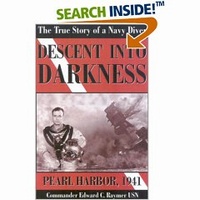
In the wake of the Raid on Pearl Harbor on December 7th, the Navy with help from civilian contractors such as Pacific Bridge went about the task of salvaging the Pacific fleet. They successfully raised 16 of the 18 ships sunk or badly damaged that day and all but the Oklahoma would be returned to action in one form or another. Only the Arizona and Utah remain on the bottom to this day.
Edward Raymer was a newly trained 2nd class Navy diver at the time of the attack and was immediately sent to Pearl Harbor to become a member of the salvage unit that was formed to assist the Base Force in the massive job of getting those ships back into the war and to clear the harbor of obstructions caused by the sunken vessels. He was doing hard hat salvage diving not SCUBA but the book is still fascinating. It is also not for the faint hearted. He describes the work in graphic detail. The first chapter describes a dive through a compartment of the Arizona that had been a battle station for about 100 crewmen. Walking through the compartment created a vortex that pulled the bodies to him. He accidently put his hand through what he thought was a bag only to find it was a corpse. His descriptions of the bones rubbing along his helmet like oriental wind chimes is chilling to say the least. It may not be for some people.
He describes in detail and on a personal level, the challenges of salvaging extremely damaged ships. They were making up the rules for safety in such an environment as they went along. Their safety record for the operation was remarkable but they did loose people to accidents that seem so mundane and predictable in retrospect but were entirely new at the time. Hydrogen Sulfide gas not only kills in high concentrations but can explode as well when under pressure for example.
He also describes the heart breaking discovery of sailors aboard the West Virginia who had survived inside the ship until at least the 23rd of December before suffocating in a compartment that had not flooded and had access to a fresh water tank. But, because that section of the ship had been pinned to the side of the Tennessee, no one had heard their tapping or had been able to sound that section of the hull.
Raymer also briefly descibes a period of duty aboard the USS Seminole in the South Pacific and around Guadalcanal. But he was back in Pearl Harbor for the raising of the Oklahoma and to give a guided tour of that ships remains to Eleanor Roosevelt.
I read Raymer`s book immediately after finishing "Resurection: Salvaging the Battle Fleet at Pearl Harbor" The books complement each other very well with Resurrection offering a big picture approach to Raymers first hand account. There is a lot of overlap and the details mesh very well. Resurrection is a more academic book with a lot of details and pages of notes at the end. Raymer is an engaging story teller with a gift for words and an up close view of an event of major importance. Both books are well worth the read.
You can find these books on Amazon.com of course, as a matter of fact they are so closely related that Amazon offers one click to buy both.
Descent Into Darkness
http://www.amazon.com/Descent-into-Darkness- Edward-Raymer/dp/0891417451/ref=pd_bbs_sr_1/ 103-2697282-5679866?ie=UTF8&s=books& qid=1183997790&sr=8-1
Resurrection
http://www.amazon.com/Resurrection-Salvaging -Battle-Fleet-Harbor/dp/1557504881/ref=pd_bxgy _b_text_b/103-2697282-5679866?ie=UTF8&qid= 1183999463&sr=8-1